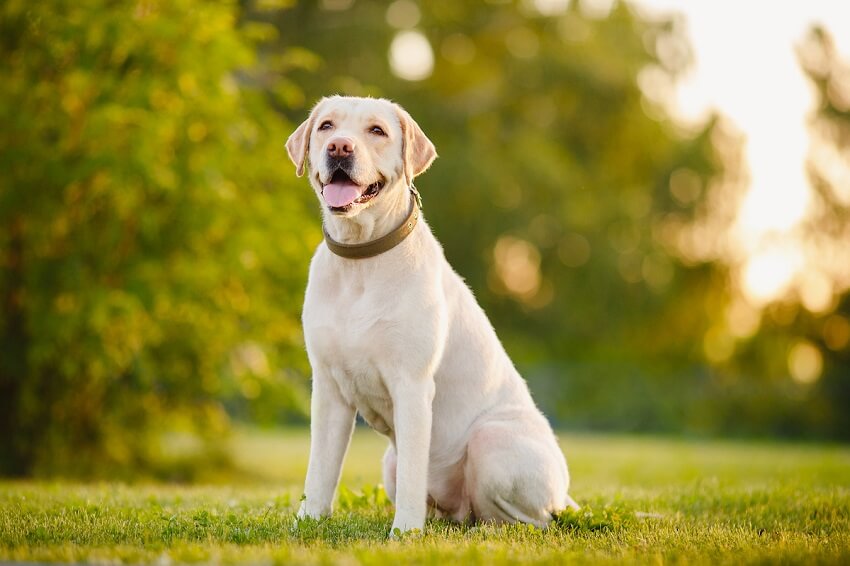The Labrador Retriever, often simply called a Lab, is a renowned gundog breed celebrated for its friendliness, devotion, and diligence. They are exceptionally gentle and affable with people. If you’re looking to acquire a Labrador Retriever as a pet, join Know ALL Animals to explore their origin, characteristics, and care guide.
Labrador Retrievers are valued for their patience and friendliness towards children. With their keen sense of smell, intelligent appearance, and trainability, they are also widely used for search and rescue and security purposes. This article will help you learn more about this fascinating dog breed.
1. Origin and History of the Labrador Retriever
The Labrador Retriever’s ancestor is the Greater Newfoundland, which originated in Canada. Initially, they were used for scenting and retrieving game in hunts.
Throughout the 18th and 19th centuries, Labs were highly favored by sailors on fishing boats. They could assist with pulling nets onto the boat, and even jump into cold ocean water to herd fish into nets and untangle them. Throughout the 1920s and 1930s, Labs quickly became popular pets in the U.S. and are currently the most commonly owned dog breed in American families.

2. Labrador Retriever Characteristics
2.1. Physical Appearance
With a medium size and a balanced, sturdy build, the Lab dog moves with the agility of a hunting dog. Labrador dogs stand out with their short, dense, and straight coat, which is waterproof and helps them operate better in water.
They also have a very soft and thick undercoat to keep their body warm and prevent insects. There are 3 common coat colors: black, yellow, or chocolate. Lab dogs’ eyes are brown or light brown with black rims. The front legs are straight, and the hind legs are slightly bent at the knees with muscular thighs. The tail extends long, forming a straight line with the body from head to tail.
The Labrador dog is a medium-sized breed, with adults having a height ranging from 52-60cm and a weight from 25-32kg. Specifically:
- Males: Height from 55-60cm, weight from 27-32kg.
- Females: Height from 52-58cm, weight from 25-30kg.
2.2. Temperament and Personality
The Labrador Retriever breed is well-known for its sweet nature and friendly disposition towards both people and other animals, making them ideal family pets. As a sporting breed, Labs love activities like running, jumping, and exercising. They are particularly fond of water and swimming, so you can even train them for various tasks.
An interesting fact about Labs is their strong appetite; they crave food to the point of eating human food. If their diet isn’t controlled, it can easily lead to obesity.
3. Labrador Retriever lifespan
Numerous studies have been conducted to understand the lifespan of Labrador Retrievers.
In the UK, two surveys were carried out in 2004 and 2013. The earlier study indicated that the average age of death for over 500 Labradors was 12.25 years. The later study reported an average age of death of 12.5 years in a group of over 400 dogs. A larger and more recent study published in 2018 examined over 30,000 Labradors, showing their median lifespan to be 12 years. Therefore, the average lifespan of a Labrador Retriever appears to be around 12 years.
However, studies reveal that not all Labrador Retrievers have the same lifespan. Chocolate Labradors tend to live shorter lives, averaging 10.7 years, compared to black and yellow Labradors.

4. Labrador Retriever price
In Western countries such as the United States, Canada, European nations, or Australia, Labrador Retrievers typically come with a relatively high price tag. Prices can range from $1,000 USD and upwards, depending on various factors like origin, purity of breed, the breeder, and other considerations.
Factors Affecting Labrador Retriever Prices:
Origin:
Labrador Retrievers imported from countries with reputable breeding standards, such as Europe, the US, or Canada, generally command higher prices than dogs bred in Vietnam or imported from other Southeast Asian countries.
Purity of Breed:
Purebred Labrador Retrievers with clear pedigree papers (like FCI/VKA certification) are usually more expensive than dogs without papers or with unclear documentation.
Breeder:
Reputable kennels with extensive experience in breeding and caring for Labrador Retrievers often have higher prices compared to individual backyard breeders or smaller pet shops.
Other Factors:
Coat color (rare colors like chocolate or golden can be more expensive), gender (females may be pricier than males), and other factors such as health and appearance also influence the price.
5. Labrador Retriever diet
Labrador Retrievers aren’t picky eaters. However, you’ll need to adjust their food intake to suit their age:
+ For young puppies, around 1-2 months old, you should feed them 4-5 meals per day. Their food can include soft rice, porridge mixed with minced meat, or dry kibble soaked in clean water.
+ When your dog is about 2-6 months old, you can feed them 3 meals per day. Foods like heart, liver, lean pork, chicken, beef, etc., should be cooked thoroughly and cut into small pieces. You can also supplement their meals with milk, fruits, or eggs for a balanced diet.
+ Labradors over 6 months old can eat foods rich in protein and calcium like bones and meat. However, you should avoid giving them large marrow bones. It’s also best to limit their bone consumption as too much can easily lead to constipation.

6. Labrador Retriever puppy care
6.1. Bathing and Hygiene
You should bathe your dog twice a week. Occasionally, use a herbal shampoo during baths to eliminate ticks, lice, fleas, and parasites that cause skin diseases in dogs. After bathing, remember to blow dry and brush their coat. You should also dedicate time each morning to brush their fur. Be sure to trim their fur and clip their nails when you notice them getting too long.
6.2. Labrador Living Space
Labrador Retrievers are extremely active dogs. Therefore, you should keep them in a house with a yard to provide them with more space to run and play. You shouldn’t confine your dog for more than 3 hours during the day.
Additionally, you should take your dog for regular walks, play games, and go swimming. If possible, you should take them to a pool a few times a month. Regularly playing with your dog will help you and your furry friend understand each other better, which is incredibly important.
6.3. Dental and Coat Care
A special characteristic of the Labrador’s coat is that it sheds very little and doesn’t easily get dirty, plus this breed doesn’t have a strong doggy odor. So, you don’t need to bathe or brush them too frequently; once a week is sufficient. Besides that, you should get your dog into the habit of brushing their teeth daily.
6.4. Training Your Labrador to “Stay”
This is the first basic lesson to help you control your dog.
Stand in front of your dog, slowly move a treat towards the top of their head. As soon as your dog stands still, say “Stay” and reward them.
Gradually extend the duration and repeat many times until your dog is accustomed to it, then stop the session.
6.5. Training Your Labrador to “Sit” and “Sit-Stay”
Stand in front of your dog, slowly move a treat towards the top of their head. Your dog will instinctively sit down; say “Sit” and reward them.
Gradually extend the duration and repeat many times until your dog is accustomed to it, then stop the session.
6.6. Training Your Labrador to “Heel” (Walk Beside You)
Stand by your Labrador’s left leg, say “Sit” to have your dog sit next to you. Then, give a gentle tug on the leash and say “Heel” or “Walk.”
If your dog walks too fast, say “Slow” to make them reduce speed. When they are parallel with your leg, say “Good.” Conversely, if they walk too slowly, say “Fast.”
6.7. Training Your Labrador to “Shake Paw”
First, sit facing your dog and place a treat in your lap.
Then, say “Shake Paw,” and at the same time, gently lift one of your dog’s paws to shake hands. Use your other hand to give your dog a treat.
You should repeat this many times to form a habit for your dog.
6.8. Training Your Labrador to “Bow” or “Wave” (Sit and Greet)
Say “Sit,” then adjust your dog’s tail and sitting posture to be correct.
Next, say “Bow” or “Wave” and pull the leash up with your left hand, supporting your Labrador’s front paws. Maintain the pose; when tired, your dog will naturally sit down.
You should also repeat this many times to form a habit for your dog.
6.9. Training Your Labrador to “Speak” or “Bark”
Hold a fragrant treat near your dog’s nose with one hand, then say “Speak” or “Bark” and snap your fingers.
Remember to repeat the action many times to form a habit for your dog.

7. Labrador Retriever health problems
7.1. Elbow Dysplasia
Often seen in large Labrador Retrievers, this condition occurs due to the different growth rates of the three bones that form the elbow, leading to a loose joint that can cause pain or even lameness.
7.2. Hip Dysplasia
This is a genetic condition where the thigh bone doesn’t fit snugly into the hip joint, causing the dog pain and limping in one or both hind legs.
7.3 Cataracts
Similar to humans, this disease causes cloudy spots to appear in the lens of the eye, gradually enlarging and, in some cases, leading to vision loss.
7.4 Osteochondrosis Dissecans (OCD)
This is a condition related to the development of cartilage in the joints, commonly found in the elbows and shoulders. The disease causes joint stiffness, leading to pain when the dog moves.
7.5 Epilepsy
Epilepsy causes mild to severe seizures, making your dog run frantically, stumble, or hide in fear.
7.6. Ear Infections
Labrador Retrievers have large ears, which makes them susceptible to infections if not cared for properly. Therefore, you need to check and clean them regularly!
8. Common Questions About Labrador Retrievers
Are Labrador Retrievers aggressive?
Labrador Retrievers are a gentle, sweet, and highly intelligent breed, making them suitable for service dog roles and assisting people. Their loyal and obedient nature makes them a great fit for families with children or other pets.
Can Labrador Retrievers be guard dogs?
Labrador Retrievers can alert you to strangers approaching, but their playful nature means they are easily enticed by strangers with a few simple tricks.
This breed will surely be a loyal and loving companion. We hope the article above has helped you understand the Labrador Retriever breed better. Why not consider getting a Labrador as a pet yourself!



